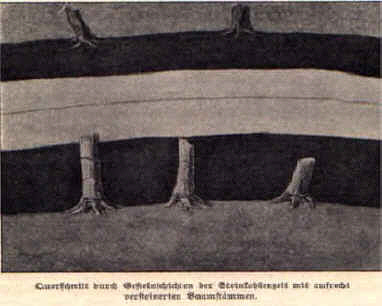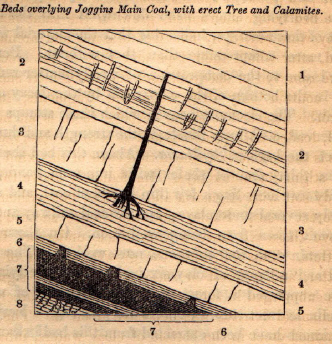Polystrate Fossils are fossils that cross multiple layers of strata.
More often than not they are fossil trees; however they can also be fossil
bones of animals or fish as well. Young Earth Creationists contend that
such fossils provide very strong evidence that the whole geological time
chart, with its millions of years, is invalidated by such things.
Evolutionists disagree, saying that they are usually in situ (or in their
natural growth position) because some of them clearly possess some, or most of
their roots.
 The
articles below provide readers with more details to make up ones mind as to which view is better
represented by the facts.
The
articles below provide readers with more details to make up ones mind as to which view is better
represented by the facts.
A
Classic Polystrate Fossil
by John D. Morris. This article talks about fossil trees in association
with coal seams and how such fossils go against millions of years of (slow)
deposition.
The
"Fossil Forests" of Nova Scotia
This article looks
closely at a number of instances of polystrate fossil trees that
were recorded by Dawson and Brown. The author goes into detail as to why
he believes that the trees are not in situ, but rather transported by
floodwaters, and why he concluded that only about 1 in 50 upright
fossil trees possess roots with attached rootlets. He also examines in
detail one such tree that did posses both roots and rootlets: this tree is
discussed in Part Two of
this paper. The author also provides evidence that these deposits
were made by ocean currents, as opposed to rivers, or river estuaries and
discusses various types of marine fossils found in this strata. One of the trees discussed in detail
was 15 feet long. Two others were 25 and 40 feet long respectively.
Fragmentation of
stigmaria roots is also discussed, as well as the pros and cons of the
autochthonous vs allochthonous deposition of coal, and whether it is the
result of Peat swamp and forest growth or organic sedimentary deposits that
resulted because of a worldwide flood. Brief mention is made of the fact
that very similar strata is found in the United States and Europe as well.
 Upright Trees in Coal:
This brief article discusses the fact that a number of documented instances
have verified that upright trees are sometimes found going through coal seams
that are between 1-3 feet thick. A drawing of one of these by Williamson
had NO traces of roots. The Drawing is included. The implications
of this suggest that coal seams are not the result of Peat Bogs, but rather
rapidly deposited (organic) sediments.
Upright Trees in Coal:
This brief article discusses the fact that a number of documented instances
have verified that upright trees are sometimes found going through coal seams
that are between 1-3 feet thick. A drawing of one of these by Williamson
had NO traces of roots. The Drawing is included. The implications
of this suggest that coal seams are not the result of Peat Bogs, but rather
rapidly deposited (organic) sediments.
Polystrate
Tree Fossils by Andrew MacRrae: This article is written from an old-earth
viewpoint. It is a summary of John William Dawson's views regarding the
upright fossil trees of Joggins, Nova Scotia. Dawson believed that many
of the upright trees in the Joggins strata were "in situ", or in
their original positions of growth; however he also readily admitted that
others were (obviously) not, since they were buried at all angles to the
strata. Dawson published an in-depth book on the Nova Scotia strata
called Acadian Geology. The first edition appeared in 1855 and three
later editions followed. Dawson was also a Christian and he did not
accept the idea that life evolved apart from the aid and direction of a
Creator.
Why
Polystrate Fossils are a Problem for (old earth) geologists to simply
explain away. This is CreationWiki's Response to the above article by
Andrew MacRae. This article states very clearly why such fossils are a
Major Problem for uniformitarian geology and the millions of years mindset: a
belief that the theory of evolution NEEDS to remain a viable theory.
See
also The Age of the Earth
for more on why Evolution NEEDS an OLD
earth.
Polystrate
Fossils and the Creation Evolution Controversy by Joe Deweese and Bert
Thompson, Ph.D.. This article contends that in a great many instances
where fossil trees exist, sedimentation must have been very rapid. In
this regard, the authors discuss a 25 meter long tree documented by Fairholme
that was inclined at an angle of 40 degrees to the strata, and intersecting at
least 10 different strata layers. The authors also provide various other
examples of polystrate fossil trees which demonstrate that very rapid
deposition and burial must have occurred. The authors also discuss the
fact that uprooted trees can be "transported and deposited upright"
by mud flows, and that this phenomenon was actually observed at Mt. St. Helens
when it erupted in 1980.
CreationWiki's
Joggins Nova Scotia page: Among other things, what looks to be like the
remains of a 30 foot fossil tree was discovered there
recently by Ian Juby. The phenomenon of negative geotropism is also
briefly discussed, as well as its implications: i.e. that the roots were
floating in place while they were being rapidly buried.
See
also: The Cliffs of
Joggins by Ian Juby.
The
Underclays of Joggins A detailed analysis of Coal Groups 1-12 based on
the writings of Dawson and Logan. The author provides evidence which
suggests allochthonous deposition for the underclays, as opposed to deposition
in place of growth (i.e. "in situ").
Evowiki's
Polystrate Fossil Page: This page presents both the in situ hypothesis, as
well as the Creationist rapid deposition viewpoints. Links are included
in the text and below.
The
Yellowstone Petrified Forests, by Dr. Coffin presents a
very detailed analysis of the fossil trees of Yellowstone National Park.
Dr. Coffin believes that the fossil trees of Yellowstone were transported by
floodwaters, as opposed to being buried in the place of their growth.
Catastrophic uprooting and subsequent burial of trees from the Mt. St. Helens
eruptions is also discussed.
Selected Quotes
by John Calder
on the Joggins Section.

After Williamson,
A Monograph on the Morphology and
Histology of Stigmaria Ficoides,
1887, p. 13. Full Size
Image
Selected
Quotes by Lesquereux with regard to floating and fragmented root
deposits found in the coal strata of Pennsylvania. These quotes are
taken from Part Two of "The 'Fossil Forests' of Nova Scotia" article
above.
Note: The drawings above are
from Upright
Trees in Coal
and
The
"Fossil Forests" of Nova Scotia.
The images are also linked to these
articles -- at the section where they are discussed.
www.earthage.org